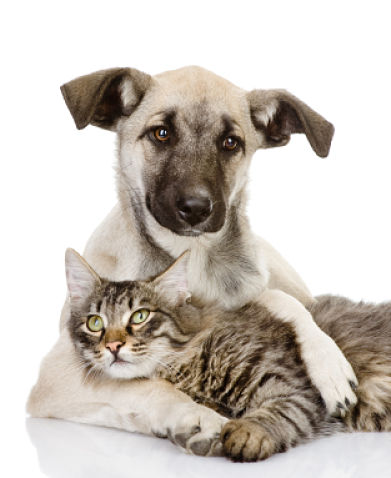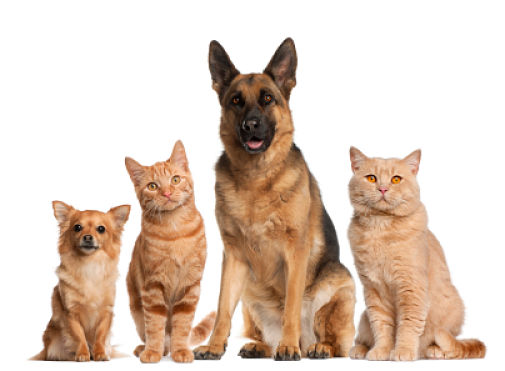Cats and Dogs ...co-existing hints

When it comes to cats and dogs, how many times have you heard people being referenced as “cat people” or “dog people? I’ll bet you’ve heard that plenty of times. However, there are people that really like both and bridging the gap between their felines and dogs takes some effort and lots of patience.
Introducing a new dog or cat to a resident animal of the opposite species requires planning, diplomacy, and patience to ensure that things run smoothly. You have to blend and mix certain basic ingredients in order to unify felines and canines. Of course you should already have had the newcomer checked out by your veterinarian and given a clean bill of health.
Other considerations will be the age, breed, temperament, and histories of both animals. Remember that introducing an adolescent of either species can be problematic because adolescence is typically a time for acting-out and rebellions. Other possible ill-fated combinations might be geriatric cats and dogs, rambunctious puppies or kittens, or a physically aggressive animal with a timid one.
However, each animal is an individual with unique needs and those may not be conventional. For instance, if your young cat has a high energy level and a penchant for trouble, introducing a young, spry dog would allow them to tire each other out while playing.
Although one geriatric cat may
be intimidated by a puppy’s antics…another may be enlivened by its presence. A canine newcomer could be just what a cat
needs to pull itself out of a slump, especially if it’s mourning the death of a
companion. Some dogs even defer to a
resident cat and accept that it was there first.
Certain ages are best for an integration attempt. A kitten is in its critical learning stages at 2-7 weeks of age and its around 3-12 weeks for puppies. While neither kittens nor puppies should be weaned before 8 weeks, exposure to members of the other species during this critical period lays the groundwork for positive reactions later. You have a better chance that your pit bull will not kill your cat by raising it from puppy-hood with your cats. Although it may kill other cats, it won’t kill yours.
Introducing an 8 week-old puppy to an 8 week-old kitten sounds like a nearly foolproof idea but be aware of other factors such as…will you have time to train and bond with two infants?
Can you afford two sterilizations within about 6 months? By the same token, in pairing up two calm, geriatric animals, consider the time and cost of caring for them medically as they age where things like diabetes, arthritis, and cancer can happen.
Another factor is the breed of dog you choose. Certain breeds of dogs have a higher prey drive than others and are victims of breed prejudices so an animal must be judged for its individual traits before drawing conclusions based solely on breed. On the flip side, don’t underestimate the fortitude of the cat, who may wind up being the primary aggressor in cats and dogs relationships.
A confident cat that perceives that it rules the household will let a dog know what is acceptable and what isn’t by hissing, growling, scratching and occasionally biting. A fearful dog and an assertive cat might not hit it off immediately, but the dog can be trained through a system of rewards to feel comfortable around cats, and the cat can be distracted from the dog with loud noises or a squirt from a water bottle. Both cats and dogs should be rewarded for positive behavior.
Your role is more difficult where dogs with high prey drive are concerned. The hardest thing to overcome is when a dog is aggressive because it views the cat as prey. Also consider the histories of the cats and dogs you’re trying to connect.
If a cat has had a negative experience with a dog, it may never overcome its fear of dogs, no matter how gentle the dog is. This stress can result in displaced aggression and/or inappropriate elimination. A dog whose only contact with cats has been chasing them, may likewise have a hard time living with one.
The key words are…take it slowly. The first step when you intend to introduce a new animal is to begin gradually making some changes that might affect your current pet. If your cat has always been fed on the floor then move your cat’s dishes to a counter where a dog won’t be able to steal the food.
You may also want to put up a baby gate to keep the dog from the litter box. Maintain the resident animal’s play schedule. Decide in advance what areas will be off-limits. Negative responses to gradual change are less likely to be associated with the arrival of the new pet.
The worst thing that you can do when introducing cats and dogs is to offer them full, immediate access to each other. After confining the new arrival in a separate room so that the animals cannot see each other, allow the animals to rub their scents on objects in their proximity and then offer these objects to the stranger on the other side of the door for inspection.
Take some of the new animal’s bedding and offer it to the resident pet. Rub both the cats and dogs with bath towels and then place the towels in the other animal’s respective sleeping areas.
The resident animal may eventually paw at the newcomer underneath a door. This limited contact allows the animals to work out fear and aggression before coming face to face. Later, you can switch their territories and allow the new pet to inspect the rest of the home while the resident pet inspects the new animal’s quarters. If you are bringing a cat into a dog’s home, this will enable the cat to find some safe spots to hide in when it’s confronted with the dog.
Remember that cats and dogs perceive their territory very differently. To cats, physical place is all important. To dogs, social place is all-important. This difference in emphasis helps your dog and cat get along better…they won’t be competing for the same vital “place”. As long as the dog accepts the cat’s dominance over territory (and most readily do), they develop a system that works for them.
Interestingly, cases of sibling rivalry rarely occur between cats and dogs. According to Dr. Nicholas Dodman, a behaviorist and author of “The Cat Who Cried for Help: Attitudes, Emotions, and the Psychology of Cats”, dogs tend to view cats as a different life form. Whereas people within a family will send signals that dogs understand, cats operate on another plane of existence. By providing food, petting, walking, and issuing and enforcing commands, people mimic the pack-like instincts of the dog. Cats don’t play the game.
Once the newcomer is familiar with the house, you can expose the animals to each other visually. Their initial response to seeing each other may be overwhelming. This is where supervision and restraint must be exercised.
Over time you will gradually reduce their circles of personal space but for the time being you should focus on controlling the actions of the dog. The cat is the one that stands to lose the most in combat.
Try to spend quality time with each of the animals before their introduction. Take the dog for a walk outside to work off nervous energy. Brush and speak soothingly to the cat in a quiet room. Offer them treats. Be present for each and every interaction of cats and dogs.
Some people install interior cat doors to enable the cat to escape if things get tense. Always have the dog tethered. If you’re not sure about its prey drive, put a muzzle on him.
Place your dog in a sitting position while allowing the cat to approach the dog. Be prepared for the dog to run toward the cat. Never force interaction. This will only increase the anxiety that the animals will have to overcome at their next meeting. A little growling or hissing is normal and shouldn’t be discouraged, but if things get too tense, separate the animals and try again later.
Maintain control over the dog throughout, and offer immediate corrections for undesirable behavior. It’s handy to have a squirt gun or pennies in a shakable can nearby so you can distract the dog from the cat if needed. Also, reward the animals for remaining calm.
Speak gently to both cats and dogs throughout the encounter. Call each by name frequently to establish verbal associations. If you are working with a puppy, refrain from too much talking, which will accelerate the puppy’s excitement. Clear, concise corrections and praise are more effective. Offer reassurance, but don’t force them to cuddle with you in an intimidating situation, as you may become the object of misplaced aggression.
If you’re working with a dog that needs to overcome some prey drive, you might want to introduce the animals by enclosing the cat in a protective cage. All other aspects of the introduction will be the same and the cage will also serve to recondition the cat to fears of the dog, making it less likely that the cat will run away, unwittingly instigating a chase.
You can watch for clues by observing the animals’ body language. This is the main form of communication between animals, and the language of cats and dogs are foreign to each other.
A dog wagging his tail would be interpreted as friendly and playful to another dog, but to a cat, a wagging tail is a signal of hostility or rage, or a warning of aggression. A dog will lift his paw gesturing that he wants to play, but a raised paw to a cat is a threat.
Allow the cat to puff up and posture in front of the dog, but be prepared to shake the pennies or give a squirt with the spray bottle if it looks like she’ll attack. While you should be equally protective of the dog’s safety, never reprimand the cat for defending itself. One swat on the nose ever killed a dog.
A dog will also send out signals before it attacks. If a dog has a history of killing animals, you’ll have a hard time training it to live with a cat. Dogs also tend to be more aggressive in a pack than by itself. If you’re working with more than one dog, be especially wary of the pack mentality.
An otherwise acceptable dog-cat relationship can also fall apart if the dog guards its food bowl. Possessiveness of food is particularly difficult to overcome, even though a dog might be amiable to the cat in every other scenario.
Even dogs that may not be aggressive toward people over food may be aggressive toward a cat over food. Cats, as solitary creatures, don’t recognize the social implications of sharing food. Try to feed your pets in separate areas to avoid tussles over food and so that they both eat in a stress-free environment.
When you begin to see acceptable interactions, and they’ve begun approaching each other, allow the dog to walk around with the leash attached. If you’re introducing a dog with a high prey drive, consult a professional before taking this step.
If you’re using a cage for the cat, then stage several meetings before allowing the cat out. The animals must feel like they’re in a safe and controlled environment, but be ready to issue a command such as “leave it!” if the dog gets excited. Only by monitoring several interactions can you start to trust the cat and dog together.
If you’ve had several interactions without incident, you can try leaving them alone for a short period. If all goes well, you can leave them together for longer periods of time.
Signs that things aren’t working are aggression that does not seem to be getting better and/or a strong fear reaction by either the cats or dogs that does not show signs of improvement, or aggression that involves injury to either animal.
It’s a good sign when cats and dogs follow their normal routines of eating, drinking, sleeping, and playing in each other’s presence. It’s also highly unlikely, once the animals have made progress that either will revert or attack without warning.
If either animal is unduly stressed, take a step back and give it more time. If they spend long periods ignoring each other, you’re on your way to a successful pairing.
Related Articles......
Return from Cats and Dogs to Cat Health Homepage
Having trouble finding what you need? Cat Health Index & Site Map
OR
Do you have a question to ask?...Questions
OR
Do you have a cat story to share?...Simply click here to go to that page!
Copyright@2010-2020 All rights reserved.Cat-health-detective.com
This website is information only. Consult a veterinarian for medical assistance

"Like Us" on Facebook
or...
"Like Us" here




















